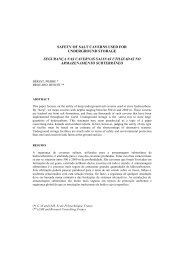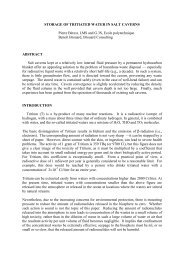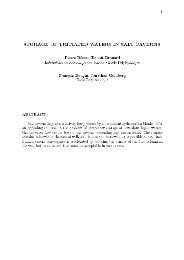Deep salt-cavern abandonment - Brouard Consulting
Deep salt-cavern abandonment - Brouard Consulting
Deep salt-cavern abandonment - Brouard Consulting
You also want an ePaper? Increase the reach of your titles
YUMPU automatically turns print PDFs into web optimized ePapers that Google loves.
water is an increasing function of pressure and<br />
temperature: an increase in P or T leads to additional<br />
dissolution. Salt dissolution is an endothermic<br />
reaction, and the volume of saturated brine is smaller<br />
than the sum of the volumes of its components (<strong>salt</strong><br />
and water). From this, any increase in P or T is<br />
followed by a slightly delayed decrease (by a few<br />
percent of the initial change; precise figures are<br />
discussed in Van Sambeek et al. 2005). In other<br />
words, the “instantaneous” thermoelastic coefficients<br />
( αb, βb, αc,<br />
β<br />
c) must be modified accordingly when<br />
slow processes are considered.<br />
In a closed <strong>cavern</strong>, V b = V c = V and Equations (1)<br />
and (2) result in<br />
( βc + βb ) = αb + α<br />
<br />
c R<br />
+ ( creep<br />
−<br />
leak<br />
−<br />
perm )<br />
P T T Q Q Q V (3)<br />
In the long term (several centuries) T , T R<br />
and P vanish<br />
to zero and there exists an “equilibrium pressure” such<br />
that Qcreep Qleak Qperm<br />
= + ( Qleak<br />
is likely to be small).<br />
One aim of an in situ test is to predict “equilibrium<br />
pressure” value. For this reason the various terms in<br />
(3) must be assessed; they are discussed in the<br />
following paragraphs.<br />
2.2 Cavern compressibility<br />
Cavern compressibility, βV<br />
= ( βc<br />
+ βb)<br />
V , is proportional<br />
to the <strong>cavern</strong> (or brine) volume. Compressibility<br />
factor β is the sum of the brine compressibility factor<br />
(β b = 2.57 x 10 -4 MPa -1 holds for a rapid injection; the<br />
“long-term” figure is β b = 2.7 x 10 -4 MPa -1 , see above)<br />
and the <strong>cavern</strong> compressibility factor, or β<br />
c<br />
, which<br />
depends upon both rock-<strong>salt</strong> elastic properties and<br />
<strong>cavern</strong> shape. A typical value of the <strong>cavern</strong><br />
compressibility factor is β c = 1.3 x 10 -4 MPa -1 , which<br />
−4 -1<br />
makes β = 4× 10 MPa ; however, larger values are<br />
sometimes encountered — for instance, when the<br />
<strong>cavern</strong> is somewhat flat (Bérest et al. 1999).<br />
Cavern compressibility can be measured simply<br />
when injecting brine and measuring the resulting brine<br />
pressure build-up. Cavern compressibility is the slope<br />
of the curve (injected brine vs brine pressure).<br />
However, mistakes can be made easily: when<br />
injecting (or withdrawing) fluids into (or from) a<br />
<strong>cavern</strong>, one may modify the composition or<br />
temperature of the fluids in the well. The relation<br />
between wellhead pressure and <strong>cavern</strong> pressure is<br />
modified accordingly, leading to possible<br />
misinterpretation.<br />
2.3 Leaks<br />
As will be seen later, the permeability of rock <strong>salt</strong> is<br />
exceedingly small in most cases. The real problem is<br />
usually the “piping”— that is, the cemented well that<br />
connects the <strong>cavern</strong> to the ground surface. Although<br />
correct and robust well designs prevent most leakages,<br />
full-scale testing is necessary to ensure that acceptable<br />
tightness exists. Tightness tests are performed before<br />
commissioning a <strong>cavern</strong> (and from time to time during<br />
<strong>cavern</strong> operation). It often is considered that the<br />
maximum allowable leak rate during such a test is<br />
3<br />
Q<br />
leak<br />
= 160 m year (Thiel 1993). Smaller apparentleak<br />
rates often are measured during actual tests and<br />
Van Sambeek et al. (2005) proved that actual tests<br />
often overestimate the actual leak. It can be assumed<br />
that such a leak, which is effective when a <strong>cavern</strong> is in<br />
operation, will be made much smaller — or even nil<br />
— had the casing been plugged and filled with cement<br />
before <strong>cavern</strong> <strong>abandonment</strong>. For this reason, it is<br />
important to measure accurately leaks that occur<br />
during an <strong>abandonment</strong> test. The leak detection system<br />
is based on the density difference between brine and<br />
oil densities. (“Green” oil often is used during in situ<br />
tests). The system is similar to that described by<br />
Diamond et al. (1993) for brine production wells. The<br />
annular space is filled with oil to down below the last<br />
casing shoe; the central tubing also contains a small<br />
amount of oil (see Fig. 1). Let Q be a <strong>cavern</strong> or brine<br />
volume change rate; it generates the same pressure<br />
drop (when Q < 0 ) or build-up ( Q > 0 ) rates in the<br />
<strong>cavern</strong> ( P wh<br />
c<br />
), as well as in both the tubing ( P <br />
tub<br />
) and<br />
the annular space ( P ) at the wellhead:<br />
wh wh<br />
tub ann c<br />
wh<br />
ann<br />
P = P = P = Q βV<br />
(4)<br />
The two curves (annular-space pressure vs time) and<br />
(central-tubing pressure vs time) are perfectly parallel<br />
(right-hand picture in Fig.1).<br />
Figure 1. Principle of the oil-leak detection system.<br />
tub<br />
A green oil leak from the central tubing ( Q<br />
o<br />
)<br />
through the wellhead produces the same pressure drop<br />
both in the central tubing and in <strong>cavern</strong> — i.e.<br />
wh<br />
tub<br />
P ann<br />
= P c<br />
=−Qo<br />
βV<br />
. However, brine density<br />
3<br />
( ρb<br />
≈ 1200 kg/m ) is larger than the density of green oil<br />
3<br />
( ρo<br />
≈ 810 kg/m ): thus, a green oil leak yields to both<br />
an upward vertical displacement of the oil/brine<br />
interface and an additional pressure drop in the central
















